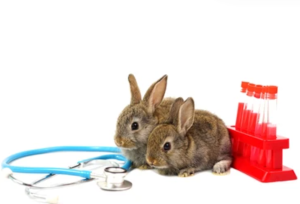89 Bunny Bellies: Hopping In and Out of Trouble
This XML file does not appear to have any style information associated with it. The document tree is shown below.
Simple Book Publishing
Wed, 29 Nov 2023 21:13:03 +0000
en-US
1.2
1
287
312
1
23
24
2
3
25
26
59
65
27
28
29
64
4
30
31
53
56
58
57
55
54
52
5
32
33
34
35
61
60
36
6
7
8
37
9
10
63
38
11
39
12
13
14
15
16
17
50
40
41
49
42
18
43
19
20
51
44
21
45
46
48
47
22
https://wordpress.org/?v=6.3.2
Fri, 17 Nov 2023 19:00:59 +0000
https://open.lib.umn.edu/app/uploads/sites/297/2014/10/profile.png
17
0
0
0
Sun, 26 Nov 2023 23:28:14 +0000
https://open.lib.umn.edu/app/uploads/sites/297/2023/11/Untitled-21.png
38
24
0
0
Sun, 26 Nov 2023 23:47:58 +0000
https://open.lib.umn.edu/app/uploads/sites/297/2023/11/Group-1.png
41
4
0
0
Sun, 26 Nov 2023 23:52:47 +0000
https://open.lib.umn.edu/app/uploads/sites/297/2023/11/Group-2.png
44
4
0
0
Mon, 27 Nov 2023 03:16:41 +0000
https://open.lib.umn.edu/app/uploads/sites/297/2023/11/Untitled-23.png
47
5
0
0
Mon, 27 Nov 2023 13:28:18 +0000
https://open.lib.umn.edu/app/uploads/sites/297/2023/11/bunnyhead.png
51
50
0
0
Mon, 27 Nov 2023 13:43:46 +0000
https://open.lib.umn.edu/app/uploads/sites/297/2023/11/Screenshot-2023-11-27-074112.png
52
50
0
0
Mon, 27 Nov 2023 14:09:03 +0000
https://open.lib.umn.edu/app/uploads/sites/297/2023/11/Screenshot-2023-11-27-080830.png
53
50
0
0
Mon, 27 Nov 2023 14:14:21 +0000
https://open.lib.umn.edu/app/uploads/sites/297/2023/11/Screenshot-2023-11-27-081331.png
54
50
0
0
Mon, 27 Nov 2023 15:14:13 +0000
https://open.lib.umn.edu/app/uploads/sites/297/2023/11/stomach.png
91
78
0
0
Mon, 27 Nov 2023 15:51:34 +0000
https://open.lib.umn.edu/app/uploads/sites/297/2023/11/Screenshot-2023-11-27-095116.png
95
94
0
0
Mon, 27 Nov 2023 16:35:49 +0000
https://open.lib.umn.edu/app/uploads/sites/297/2023/11/cecum.png
119
112
0
0
Mon, 27 Nov 2023 16:37:51 +0000
https://open.lib.umn.edu/app/uploads/sites/297/2023/11/large-intestine.png
121
114
0
0
Mon, 27 Nov 2023 18:30:03 +0000
https://open.lib.umn.edu/app/uploads/sites/297/2023/11/Screenshot-2023-11-27-122749.png
123
73
0
0
Mon, 27 Nov 2023 19:11:25 +0000
131
16
0
0
Tue, 28 Nov 2023 03:38:11 +0000
https://open.lib.umn.edu/app/uploads/sites/297/2023/11/poop-chart.png
137
99
0
0
Tue, 28 Nov 2023 03:44:00 +0000
https://open.lib.umn.edu/app/uploads/sites/297/2023/11/mucus-poop.png
138
99
0
0
Tue, 28 Nov 2023 03:44:01 +0000
https://open.lib.umn.edu/app/uploads/sites/297/2023/11/normal-cecotrope.png
139
99
0
0
Tue, 28 Nov 2023 03:44:02 +0000
https://open.lib.umn.edu/app/uploads/sites/297/2023/11/normal-poop.png
140
99
0
0
Tue, 28 Nov 2023 03:44:23 +0000
https://open.lib.umn.edu/app/uploads/sites/297/2023/11/diarrhea.png
141
99
0
0
Tue, 28 Nov 2023 03:45:32 +0000
https://open.lib.umn.edu/app/uploads/sites/297/2023/11/linked-poop.png
142
99
0
0
Tue, 28 Nov 2023 03:45:33 +0000
https://open.lib.umn.edu/app/uploads/sites/297/2023/11/small-poop.png
143
99
0
0
Tue, 28 Nov 2023 04:06:11 +0000
https://open.lib.umn.edu/app/uploads/sites/297/2023/11/Screenshot-2023-11-27-220547.png
145
99
0
0
Tue, 28 Nov 2023 04:13:38 +0000
https://open.lib.umn.edu/app/uploads/sites/297/2023/11/POOP-NOT-FOUND.png
146
99
0
0
Tue, 28 Nov 2023 04:17:46 +0000
https://open.lib.umn.edu/app/uploads/sites/297/2023/11/DARK-POOP.png
147
99
0
0
Tue, 28 Nov 2023 04:23:36 +0000
https://open.lib.umn.edu/app/uploads/sites/297/2023/11/Screenshot-2023-11-27-222315.png
148
99
0
0
Tue, 28 Nov 2023 04:52:07 +0000
https://open.lib.umn.edu/app/uploads/sites/297/2023/11/Screenshot-2023-11-27-225138.png
156
80
0
0
Tue, 28 Nov 2023 04:59:44 +0000
https://open.lib.umn.edu/app/uploads/sites/297/2023/11/Screenshot-2023-11-27-225918.png
157
80
0
0
Tue, 28 Nov 2023 05:07:53 +0000
https://open.lib.umn.edu/app/uploads/sites/297/2023/11/Screenshot-2023-11-27-230638.png
158
80
0
0
Tue, 28 Nov 2023 05:14:33 +0000
https://open.lib.umn.edu/app/uploads/sites/297/2023/11/wepik-sdhrs-food-pyramid-color-20230721180514KHID-1.png
160
97
0
0
Tue, 28 Nov 2023 05:16:21 +0000
https://open.lib.umn.edu/app/uploads/sites/297/2023/11/Screenshot-2023-11-24-141655.png
161
97
0
0
Tue, 28 Nov 2023 05:16:25 +0000
https://open.lib.umn.edu/app/uploads/sites/297/2023/11/Screenshot-2023-11-24-141545.png
162
97
0
0
Tue, 28 Nov 2023 05:16:29 +0000
https://open.lib.umn.edu/app/uploads/sites/297/2023/11/Screenshot-2023-11-24-141118.png
163
97
0
0
Tue, 28 Nov 2023 13:47:32 +0000
https://open.lib.umn.edu/app/uploads/sites/297/2023/11/Screenshot-2023-11-28-074659.png
166
78
0
0
Tue, 28 Nov 2023 13:52:29 +0000
https://open.lib.umn.edu/app/uploads/sites/297/2023/11/Screenshot-2023-11-28-075124.png
169
78
0
0
Tue, 28 Nov 2023 15:47:49 +0000
https://open.lib.umn.edu/app/uploads/sites/297/2023/11/IMG_5049.png
177
103
0
0
Tue, 28 Nov 2023 15:54:38 +0000
https://open.lib.umn.edu/app/uploads/sites/297/2023/11/1699500043621.jpeg
180
103
0
0
Tue, 28 Nov 2023 17:07:26 +0000
https://open.lib.umn.edu/app/uploads/sites/297/2023/11/Screenshot-2023-11-28-110700.png
183
97
0
0
Tue, 28 Nov 2023 18:10:05 +0000
https://open.lib.umn.edu/app/uploads/sites/297/2023/11/cecum-and-colon.png
195
112
0
0
Tue, 28 Nov 2023 18:24:19 +0000
https://open.lib.umn.edu/app/uploads/sites/297/2023/11/Screenshot-2023-11-27-083859.png
200
62
0
0
Fri, 17 Nov 2023 19:00:58 +0000
6
0
1
0
Mon, 27 Nov 2023 14:36:05 +0000
<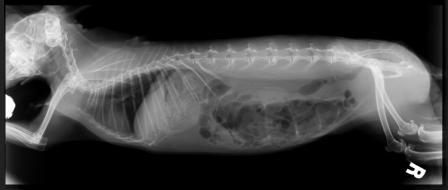
There can be one or more of the following conditions present:
- Impactions of the stomach, intestines or cecum
- Gas accumulation of the stomach, intestines or cecum
- Intestinal obstruction
- Pancreatitis
- Adhesions
- hepatic lipidosis
- liver lobe torsion
- Cholangiohepatitis
Other clinical signs and examination findings include:
- Lethargy
- Dehydration
- Abdominal distension
- Hunched back
- Grinding teeth
How do rabbits get RGIS?
RGIS falls into one of these categories:
- Dietary
- Stress/pain
- Primary gastrointestinal disease
- Systemic disease
Dietary
Rabbits eat a high fiber, low energy density diet. They are hindgut fermenters. Fiber promotes gastrointestinal motility.
- Not enough fiber = slow GI. Slow GI can change the symbiosis between gut flora and the intestinal tract resulting in overgrowth of pathogens like Clostridium sp.
- Changing diet too quickly.
- Non-washed or wilted vegetables.
- Lack of transition between hay bags (each hay bag can vary).
- High carbohydrate meals like fruits, treats, oats, nuts, and seeds.
- Lack of water.
Stress/Pain
Stress and pain can decrease gastrointestinal motility in rabbits. Stress can be from a single incident like fireworks or a long term situation like the addition of a new pet. Pain can be acute (intense) such as an injury or even chronic issues like osteoarthritis. Uneven wear of teeth can also cause gastrointestinal upset, either because it causes dysphagia or because the teeth have worn down to sharp points that hurt the cheeks and tongue. We will learn about how to identify pain in rabbits in the next section…
Primary Gastrointestinal Disease
This group of diseases can be more challenging than most. Clinical signs can look like RGIS and there may be a history of diet change or stress, but the real diagnosis can be fatal if ignored.
Systemic Disease
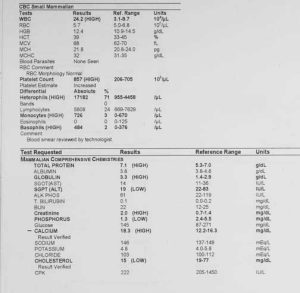 Many systemic diseases cause stress and pain. It is important to manage stress and pain as well as the disease itself.
Many systemic diseases cause stress and pain. It is important to manage stress and pain as well as the disease itself.
- Chronic renal disease (kidney disease)
- Neoplasia (cancer) of any type
- Reproductive disorders
- Lead toxicity
- Otitis media (ear infection)
Reasons to bring a bunny to the vet…
- Internal parasites
- Bacterial or viral enteric infections
- Foreign material ingestion
- Obstructions
- Malocclusion
- Signs the bunny may be in pain
]]>
62
66
1
0
Mon, 27 Nov 2023 14:59:50 +0000
<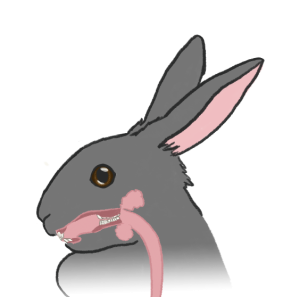 The function of teeth is to physically break down food into smaller pieces. Rabbits have aradicular hypsodont teeth. Unlike human, dogs and cats, rabbits have teeth that continue to grow throughout their lifetime. They have an “open root,” so they do not have a defined root, which allows them to constantly replace the part of the tooth that gets worn down as they eat the rough fiber of their diet (i.e. hay.) Other animals with teeth in this category include guinea pigs and chinchillas.
The function of teeth is to physically break down food into smaller pieces. Rabbits have aradicular hypsodont teeth. Unlike human, dogs and cats, rabbits have teeth that continue to grow throughout their lifetime. They have an “open root,” so they do not have a defined root, which allows them to constantly replace the part of the tooth that gets worn down as they eat the rough fiber of their diet (i.e. hay.) Other animals with teeth in this category include guinea pigs and chinchillas.
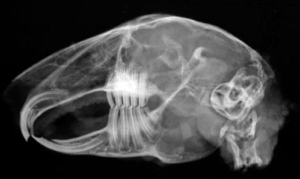
When a rabbit chews hay, they chop it up with their sharp incisors (their front teeth) and then grind it down with their “cheek teeth,” a group of molars near the back of the mouth that grind down the plant material to be swallowed. Chewing food increases the surface area thereby increasing the rate of reaction with digestive enzymes. Salivary glands filled with saliva and enzymes to start breaking down starch to convert it into sugar. The saliva also provides lubrication for the food to go down the esophagus, the tube of muscle that connects the mouth to the stomach.
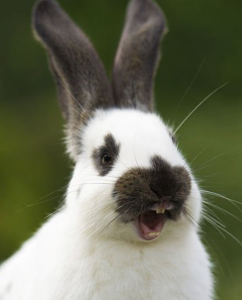
A lot can go wrong when your teeth can’t stop growing. These bunny rabbits need constantly eat hay to wear down their teeth, but what happens if they don’t have enough access to hay, or if their teeth are misaligned? Rabbits that don’t get enough fiber/hay run the risk of overgrowing their teeth. The teeth will often wear down unevenly, causing sharp spurs on the cheek teeth that cut into the tongue and cheeks.

Malocclusion (misaligned teeth) can lead to overgrown teeth, making it difficult or even painful for a rabbit to chew their food. The rabbit could be getting the adequate fiber they need in their diet, butthe misalignment of their teeth prevent them from grinding them down. Either condition can cause the rabbit to stop eating, which is an emergency situation that needs immediate attention. You will learn more about this later on in the book.

]]>
73
50
1
0
The Stomach and Small Intestine (Guest Starring the Liver and Pancreas!)
Mon, 27 Nov 2023 15:03:22 +0000
The Stomach and Small Intestine (Guest Starring the Liver and Pancreas!)
<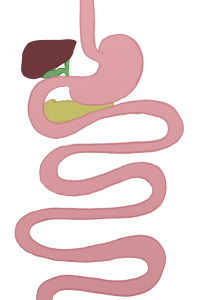
The Stomach
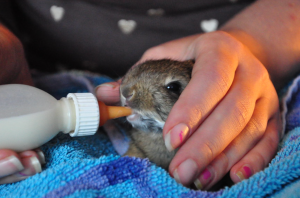
From the mouth, down the esophagus, the chewed up food drops into the stomach. Rabbits have a stomach similar to humans in terms of function, but it is shaped in a way that prevents rabbits from vomiting. Rabbits have a stomach pH of 1 to 1.6, so it is really quite acidic! The hydrochloric acid sterilizes the vegetation the rabbit swallowed, and digestive enzymes from the stomach begin to break down the chewed food pieces even more. The rabbit’s stomach is relatively small, so the food, now called chyme, leaves the stomach through the pylorus (the sphincter that connects the stomach to the small intestines) fairly quickly.
The Small Intestine
The small intestine is made up of 3 parts: the duodenum, the jejunum, and the ileum. As the chyme enters the small intestine, the stomach acid is neutralized while the chyme, now digesta, encounters enzymes produced by the pancreas that break it down to proteins, sugars and starches that can be absorbed. The liver creates bile, a yellow-green fluid, that gets stored in the gallbladder and released into the duodenum to help break down any fats the rabbit ingests. As the digesta gets moved along the small intestine, it continues to absorb the proteins, sugars and starches, all the while pushing the indigestible fiber left over down to the cecum, our next major part of the digestive tract (and perhaps the most important.) ]]>
78
50
1
0
Diagnosis and Treatment of RGIS (Let’s Make That Bunny Feel Better!)
Mon, 27 Nov 2023 15:05:23 +0000
Diagnosis and Treatment of RGIS (Let’s Make That Bunny Feel Better!)
<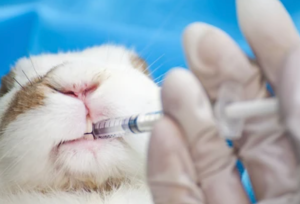 Treatment focuses on four main areas:
Treatment focuses on four main areas:
- Fluid therapy
- Nutritional support
- Pain relief/promotility medication
- Management of any underlying diseases or causes
Fluid Therapy – Main ways to deliver fluids are by mouth, subcutaneous injection (fluid under the skin), or IV (sending fluid straight into the veins), depending on the increase of severity of dehydration respectively. Nutritional Support – Instituted ASAP to promote motility and prevent hepatic lipidosis. We usually use a slurry of finely chopped hay and water (a common product is Critical Care by Oxbow) and feed it to the rabbit through a syringe. Pain Relief/Promotility Medication – Pain and a non-motile gastrointestinal tract exacerbate each other to complicate RGIS. Use lidocaine intravenously for both pain and motility. Motility enhancers like metoclopramide and cisapride are routinely used, but may not have any real effects on the rabbit gastrointestinal system. Underlying Disease – Treat as indicated for the specific disease syndrome.
This is a long video, but it goes over how to spot, diagnose, and treat RGIS!
]]>
80
66
2
0
<![CDATA[
https://youtube.com/watch?v=MG1bmGy4DwM%3Ffeature%3Doembed
]]>
<![CDATA[
https://youtube.com/watch?v=MG1bmGy4DwM%3Ffeature%3Doembed
]]>
Mon, 27 Nov 2023 15:54:57 +0000
<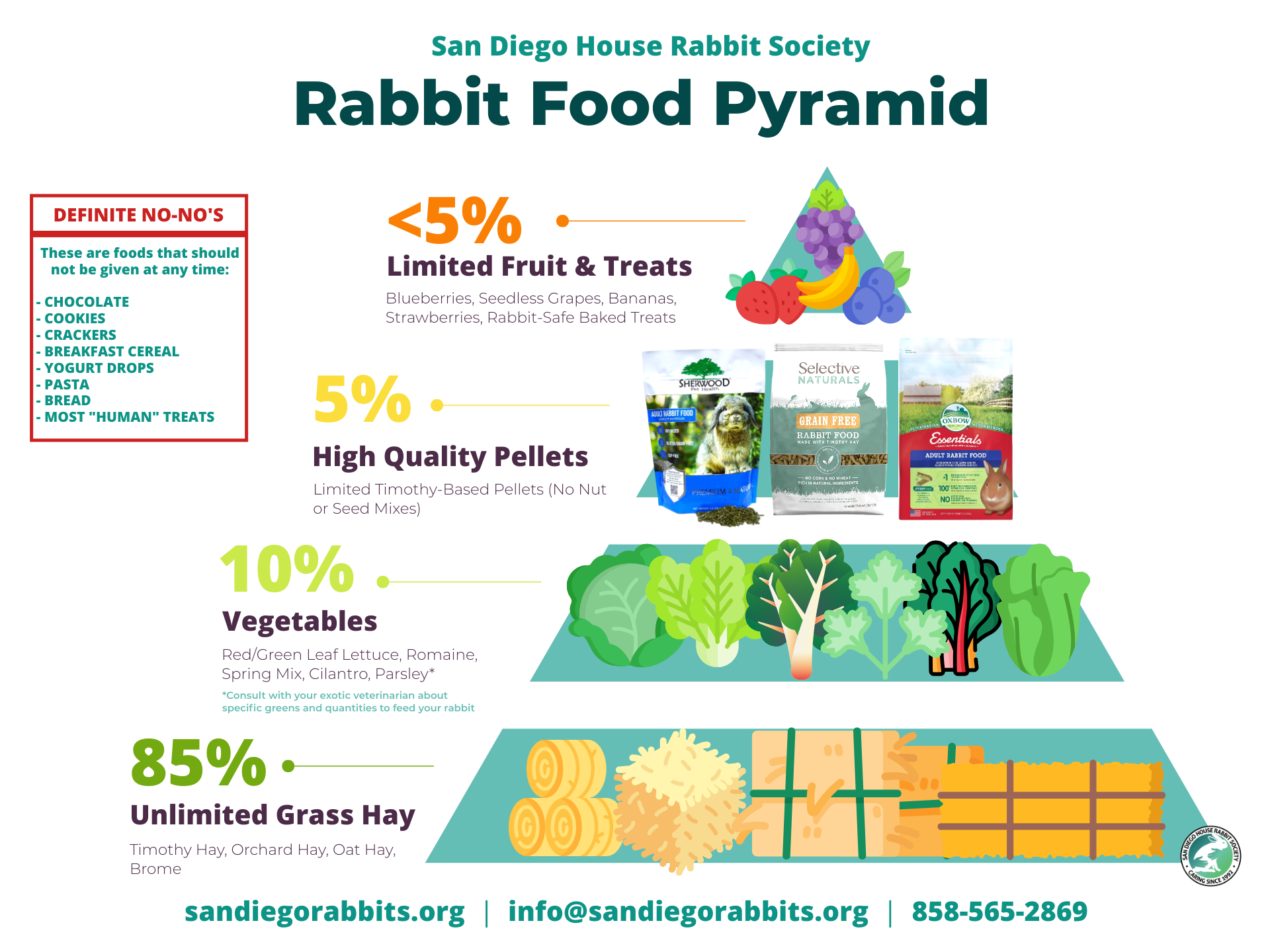
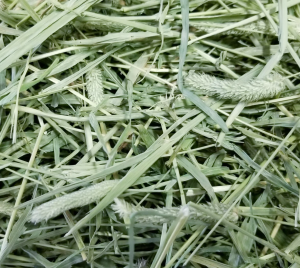
Some studies have shown that the rabbit can recognize basic flavors, such as salty, sweet, bitter, sour. Some bunnies show a preference for sweet flavors, and choose, for example, a feed containing additional sugar or molasses rather than a food of the same composition containing no additional sweeter. You should keep a close eye on that sugar content or else your bunny will end up with a tooth abscess or gain too much weight!
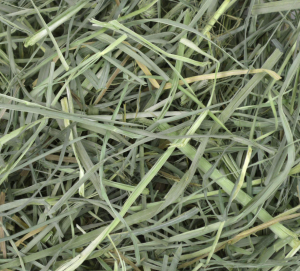
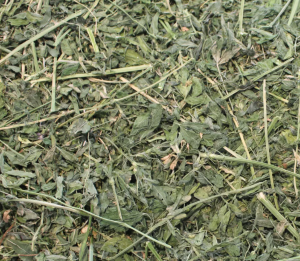
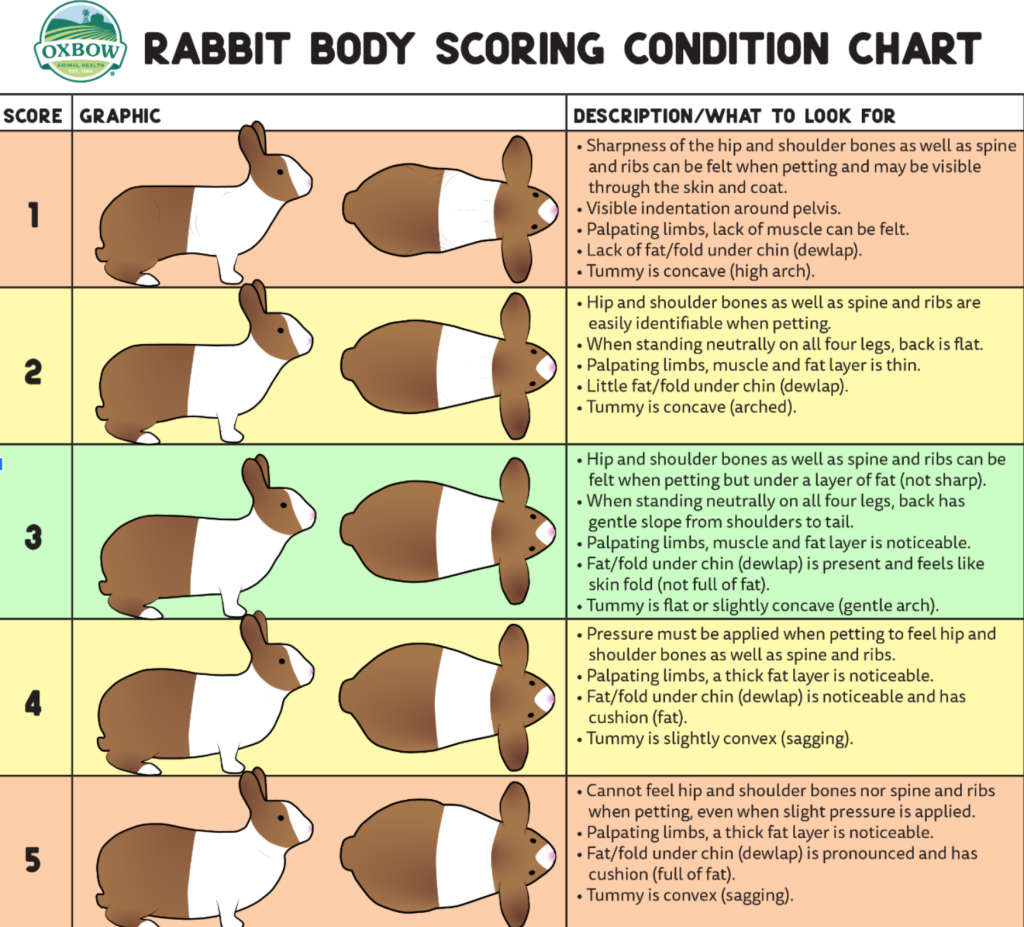 ]]>
]]>
97
94
1
0
<![CDATA[
https://youtube.com/watch?v=KsAyo3fgzWQ%3Ffeature%3Doembed
]]>
<![CDATA[
https://youtube.com/watch?v=KsAyo3fgzWQ%3Ffeature%3Doembed
]]>
Mon, 27 Nov 2023 15:57:45 +0000
<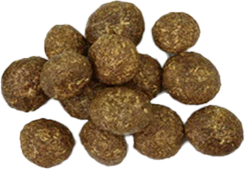 Normal rabbit poop doesn’t have much of a smell and it is dry – but not hard, it should break apart easily. Taking a look at their poop can tell you a lot about their digestive system, current state of health, and even if they may have parasites.
Normal rabbit poop doesn’t have much of a smell and it is dry – but not hard, it should break apart easily. Taking a look at their poop can tell you a lot about their digestive system, current state of health, and even if they may have parasites.
Cecotropes
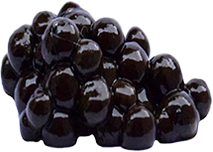 A normal type of poop for bunnies. Cecotropes are small moist, soft pellets that contain vitamins and nutrients vital to the good health of a rabbit. They look like very small grape clusters and are coated in a mucous membrane, which protects them. These cecotropes are then re-ingested by the rabbit, where the mucous membrane protects them as they pass through the entire GIT again, providing additional nutrients vital to a rabbit.
A normal type of poop for bunnies. Cecotropes are small moist, soft pellets that contain vitamins and nutrients vital to the good health of a rabbit. They look like very small grape clusters and are coated in a mucous membrane, which protects them. These cecotropes are then re-ingested by the rabbit, where the mucous membrane protects them as they pass through the entire GIT again, providing additional nutrients vital to a rabbit.
Tiny Poops
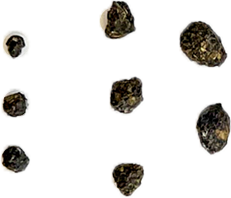 Your rabbit is in pain – stress creates variations in stool size Intestinal parasites Intestinal impaction – blockages and build-up inside your rabbit’s digestive system Malnutrition – your bunny may need access to better quality hay or they could have dental issues Stress – this is always on the list as a possibility
Your rabbit is in pain – stress creates variations in stool size Intestinal parasites Intestinal impaction – blockages and build-up inside your rabbit’s digestive system Malnutrition – your bunny may need access to better quality hay or they could have dental issues Stress – this is always on the list as a possibility
Chain Links
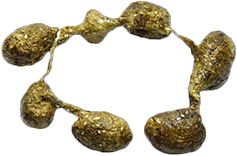 Bunnies love to be clean, so they groom themselves a lot. Ingesting a small amount of fur every once in a while is fine, but beware of obstructions!
Bunnies love to be clean, so they groom themselves a lot. Ingesting a small amount of fur every once in a while is fine, but beware of obstructions!
Dark Poop
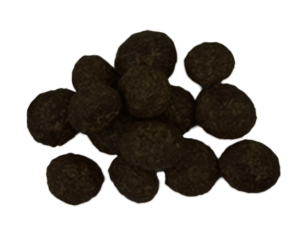 Dark poop can mean your rabbit is getting too much protein, leading to weight gain, stomach upset, and diarrhea.
Dark poop can mean your rabbit is getting too much protein, leading to weight gain, stomach upset, and diarrhea.
Misshapen Poops
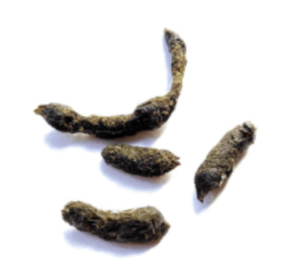 Could mean there is not enough fiber in your rabbit’s diet.
Could mean there is not enough fiber in your rabbit’s diet.
Diarrhea
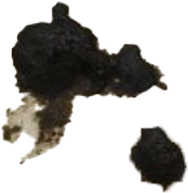 Diarrhea is a big concern for rabbits because it can cause dehydration. Immediately provide water and electrolytes. Diarrhea can be caused by infection, stress, parasites, or other underlying illnesses.
Diarrhea is a big concern for rabbits because it can cause dehydration. Immediately provide water and electrolytes. Diarrhea can be caused by infection, stress, parasites, or other underlying illnesses.
Cecal Dysbiosis
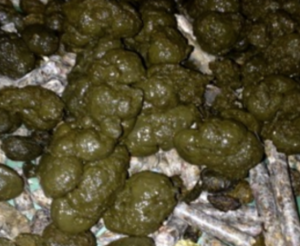 When a rabbit has Cecal Dysbiosis, the poop that is produced isn’t completely formed, is doughy or pasty, and very smelly. It can be caused by stress, illness or a diet too rich in starch, fat or sugar.
When a rabbit has Cecal Dysbiosis, the poop that is produced isn’t completely formed, is doughy or pasty, and very smelly. It can be caused by stress, illness or a diet too rich in starch, fat or sugar.
Mucus-covered Poop
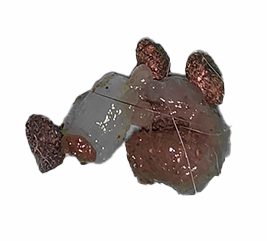 Mucous might be present for parasites or other very serious disorders like cecal impaction.
Mucous might be present for parasites or other very serious disorders like cecal impaction. 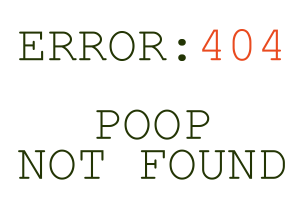 No Poop could mean your bunny is: Impacted – a build-up of stool inside your rabbit (caused by a blockage) Dehydrated Malnourished – how are their teeth? Stressed out – just like humans, stress can cause both diarrhea and constipation.
No Poop could mean your bunny is: Impacted – a build-up of stool inside your rabbit (caused by a blockage) Dehydrated Malnourished – how are their teeth? Stressed out – just like humans, stress can cause both diarrhea and constipation.
Here’s a helpful chart!
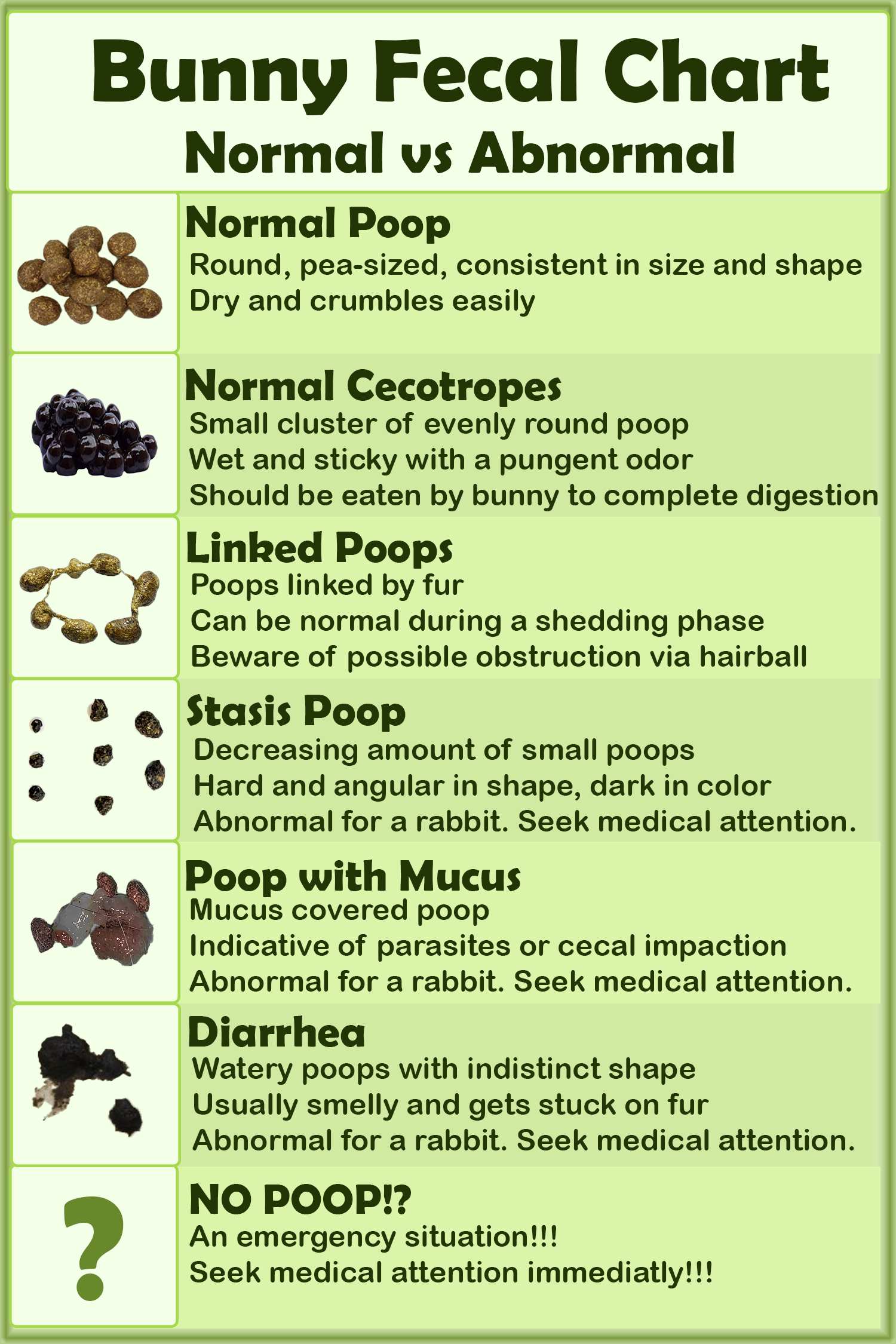
Check out this video, too!
]]>
99
94
2
0
<![CDATA[
https://youtube.com/watch?v=MiwPqQlvEPI%3Ffeature%3Doembed
]]>
<![CDATA[
https://youtube.com/watch?v=MiwPqQlvEPI%3Ffeature%3Doembed
]]>
The Cecum! A Big Fermentation Vat! (Feat. The Rest of the Large Intestine)
Mon, 27 Nov 2023 16:25:20 +0000
The Cecum! A Big Fermentation Vat! (Feat. The Rest of the Large Intestine)
<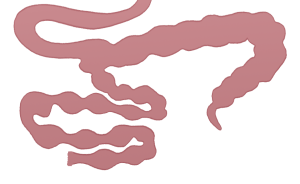
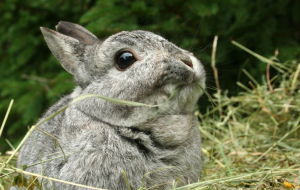 Herbivores, animals that only eat vegetation, cannot digest fiber on their own. These animals have evolved ways to “employ” microbes (microscopic organisms like protozoa, bacteria, and yeast) in their digestive tract to eat the fiber for them! The byproducts from these microbes provide much needed vitamins, fatty acids and proteins to keep their bodies functioning! It is a process called fermentation. Some animals, like the cow, use a compartment in their stomach called the rumen to store microbes. Rabbits, on the other hand, store their microbes in the cecum. Because the cecum is near the back end
Herbivores, animals that only eat vegetation, cannot digest fiber on their own. These animals have evolved ways to “employ” microbes (microscopic organisms like protozoa, bacteria, and yeast) in their digestive tract to eat the fiber for them! The byproducts from these microbes provide much needed vitamins, fatty acids and proteins to keep their bodies functioning! It is a process called fermentation. Some animals, like the cow, use a compartment in their stomach called the rumen to store microbes. Rabbits, on the other hand, store their microbes in the cecum. Because the cecum is near the back end
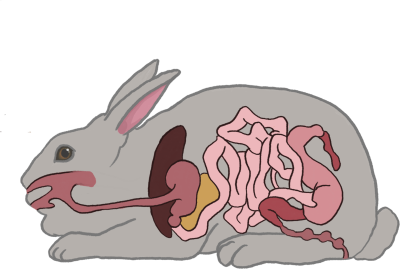 of the digestive tract, rabbits are what we call “hindgut fermenters.” After the digesta leaves the ileum of the small intestine, it splits into two paths depending on the size of the food particles. Long fibers move on to the pass along through the cecum and then out the ]the colon to be processed into fecal pellets. The shorter bits of fiber leave the cecum after passing through with the long fibers, but then move retrograde up the proximal large intestine to be fermented by the microbes back in the cecum. The cecal wall forms a spiral with 22-25 coils, thus increasing the mucosal surface area in contact with the cecal content. Some of these nutrients are absorbed directly into the wall of the cecum. After approximately 8 hours in the cecum, the digesta that wasn’t able to be absorbed through the cecal wall is pooped out in the form of cecotropes, which the bunny will eat after it leaves the rectum and anus to be digested a second time around. This is an important part of bunny digestion–it allows the rabbit to get the most out of their plant based diet!
of the digestive tract, rabbits are what we call “hindgut fermenters.” After the digesta leaves the ileum of the small intestine, it splits into two paths depending on the size of the food particles. Long fibers move on to the pass along through the cecum and then out the ]the colon to be processed into fecal pellets. The shorter bits of fiber leave the cecum after passing through with the long fibers, but then move retrograde up the proximal large intestine to be fermented by the microbes back in the cecum. The cecal wall forms a spiral with 22-25 coils, thus increasing the mucosal surface area in contact with the cecal content. Some of these nutrients are absorbed directly into the wall of the cecum. After approximately 8 hours in the cecum, the digesta that wasn’t able to be absorbed through the cecal wall is pooped out in the form of cecotropes, which the bunny will eat after it leaves the rectum and anus to be digested a second time around. This is an important part of bunny digestion–it allows the rabbit to get the most out of their plant based diet!
Watch this video to see a walk-through of the process!
]]>
112
50
2
0
<![CDATA[
https://youtube.com/watch?v=7s-GhDknV1A%3Ffeature%3Doembed
]]>
<![CDATA[
https://youtube.com/watch?v=7s-GhDknV1A%3Ffeature%3Doembed
]]>
Tue, 28 Nov 2023 18:27:34 +0000
https://open.lib.umn.edu/app/uploads/sites/297/2023/11/GI-statis-Rabbit-Angell.jpg
202
62
0
0
Tue, 28 Nov 2023 18:31:17 +0000
https://open.lib.umn.edu/app/uploads/sites/297/2023/11/Rabbit-blood-panel.jpg
204
62
0
0
Tue, 28 Nov 2023 18:54:50 +0000
https://open.lib.umn.edu/app/uploads/sites/297/2023/11/Screenshot-2023-11-28-125352.png
212
73
0
0
Tue, 28 Nov 2023 18:55:03 +0000
https://open.lib.umn.edu/app/uploads/sites/297/2023/11/Screenshot-2023-11-28-125426.png
213
73
0
0
Tue, 28 Nov 2023 19:09:40 +0000
https://open.lib.umn.edu/app/uploads/sites/297/2023/11/1fIf7o3.gif
223
108
0
0
Tue, 28 Nov 2023 19:12:19 +0000
https://open.lib.umn.edu/app/uploads/sites/297/2023/11/Screenshot-2023-11-28-131202.png
226
108
0
0
Tue, 28 Nov 2023 20:18:19 +0000
<![CDATA[ Where should my bunny live? Bunnies are small and delicate little creatures, so they live better lives inside the house with you! Your bunny does not need a cage, and in fact can live a wonderful life hopping free around your house. However, if your rabbit is not specifically trained, they should have a “home base” where they can live whenever you’re either not home or asleep. House Rabbit Society reccomends an excercise pen rather than a cage, since those offer your bunny more room to run and play. Excercise pens are also much easier to pick up and move than a cage, so that you and your rabbit can move around from time to time if you need to. What should my bunny house look like? The bigger the bunny’s home is, the better for the bunny! The enclosure shoud be at least 4-6 times bigger than your bunny when it is fully stretched out. Adding on to this, the bunny’s house should be even bigger than that if the bunny will be there for most of the day. House Rabbit Society recccomends there should be at least 8 square feet of enclosure space and 24 square feet of excercise space, which will be good enough for 1-2 rabbits. What should be in my bunny’s home? Your bunny should have a litter box (to go poop in, of course) an a little hidey box for some exra privacy. A nice soft towel or rug makes a good floor for thier homebase, and things like hard plastic baby toys and something wooden are good for the bunny to play with and chew on while you’re busy. If you have the bunny outside while you’re home and put them away when you leave, you can use a nice fruit or veggie snack to make going into their little house a more positive experience. When can my bunny go out and play? Rabbits are crepuscular, which means they sleep during the daytime and the nightime but are awake and ready to play during the morning and evening. Because of this, the best time to let your bunny go out and play is in the morning, when you are getting ready for school, and in the evening when you are doing homework and eating dinner.
https://houserabbit.org/new-to-pet-rabbits/rabbit-housing/
]]>
232
108
1
0
<![CDATA[
https://bunnylady.com/free-roam-rabbit/embed/#?secret=UxR2bNIHO6#?secret=bZXEoxQnoV
]]>
<![CDATA[
]]>
<![CDATA[
]]>
<![CDATA[
https://bunnylady.com/free-roam-rabbit/embed/#?secret=wFpRC8q1Lf#?secret=nlT3flYdc1
]]>
Wed, 29 Nov 2023 03:17:54 +0000
<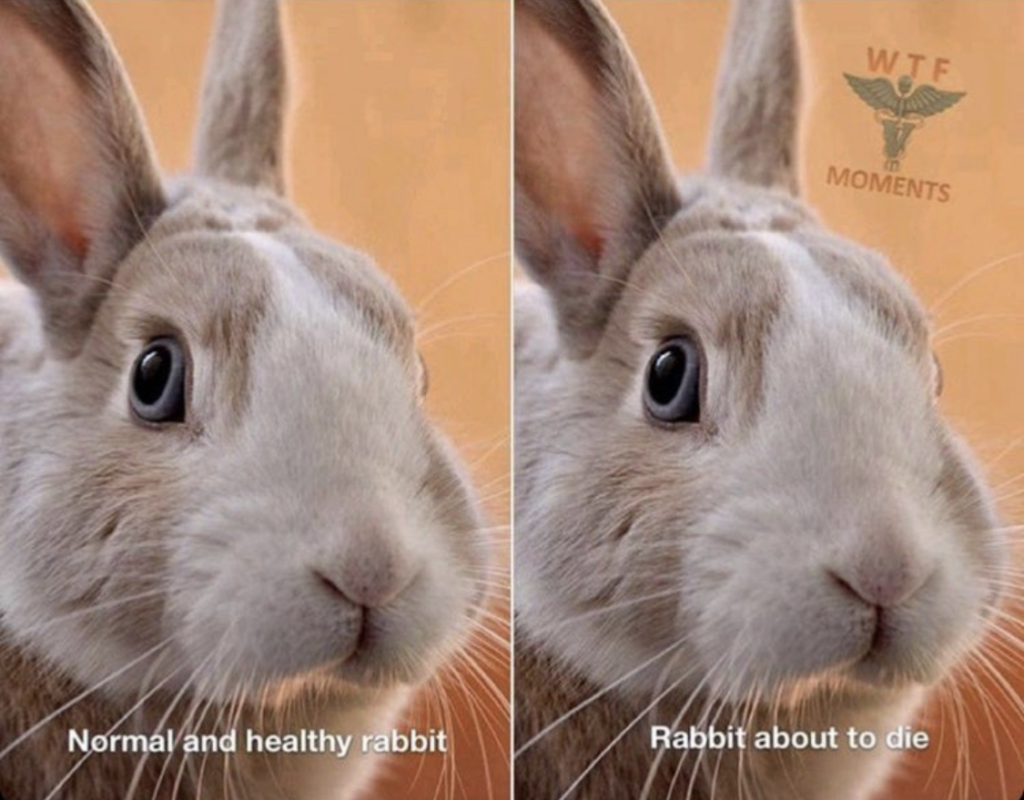
Rabbits are prey animals…
Prey animals hide signs that they are in pain or sick–this prevents predators from singling them out as an easy catch. Unfortunately for us, this means it can be hard to identify when our bunnies are not feeling well. Here are some helpful examples of bunny body language you can use to identify an ill rabbit. Remember: a rabbit experiencing pain can lead to them developing secondary RGIS!
Below are a couple of helpful resources to learning how to spot a sick and/or painful bunny!
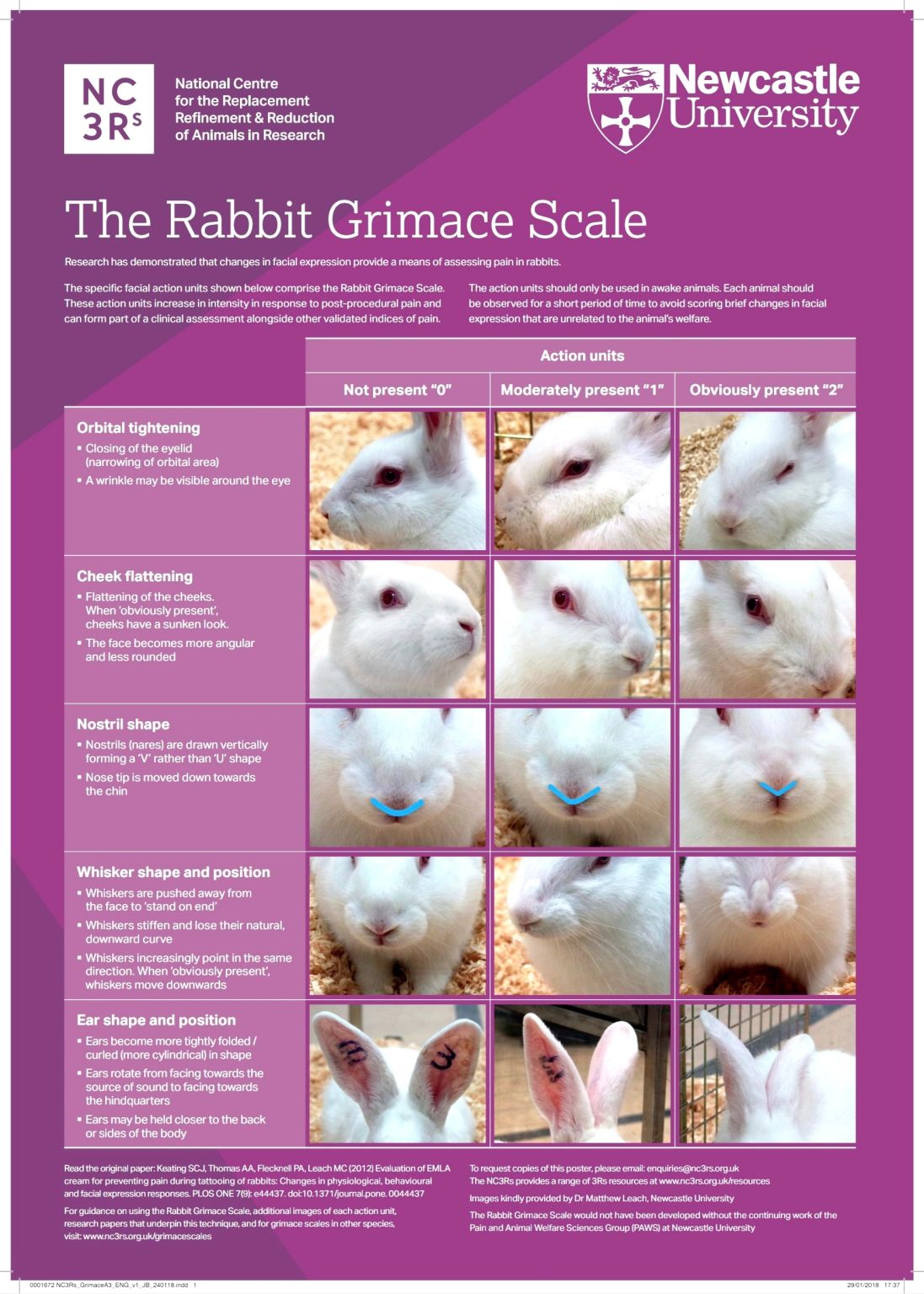 ]]>
]]>
235
66
3
0
<![CDATA[
https://youtube.com/watch?v=sXyW9zPgZ6Y%3Ffeature%3Doembed
]]>
<![CDATA[
https://youtube.com/watch?v=sXyW9zPgZ6Y%3Ffeature%3Doembed
]]>
Wed, 29 Nov 2023 16:14:58 +0000
<![CDATA[ Can I play with my bunny? Yes! You can absolutly play with your bunny, and doing so is important for their health! Playing with your bunny keeps them moving and prevents diseases like GI stasis and RGIS. Let’s talk about how! What kinds of games do bunnies like? In order to play a game that both you and your bunny can enjoy, it’s important to understand what a bunny does naturally. Bunnies have instincts that lead them to dig, chew, and forage. These are the most natural things for a bunny to do, and the best games you and your bunny can play allow it to do these things in creative, fun ways. For example, one thing that bunnies like to do is pick things up with their teeth and toss them. You can give your bunny a ball they can hold in their teeth, like a willow ball, that they can pick up and toss away. If you don’t have a willow ball, you can also use things like wooden blocks, stacking cups, and toilet paper tubes. You can also make a rabbit maze, though this is a bit more complex than reverse fetch. You can either use cardboard boxes or furniture in the house, and shape those into an obstacle course for your bunny to hop through. Then, you can use treats to guide your bunny through the maze. How else can I bond with my bunny? Remember that your bunny is a companion, and can be bonded with just like a friend! This helps your bunny to feel safe, which lowers their stress and keeps them healthy. Rabbits love fruits and veggies as treats, so if you’re munching on an apple or a carrot, hold it down toward your rabbit so that they can take a bite out of it. As long as you make sure your bunny doesn’t eat too much, this is a great way to spend some quality time with it. Another thing you can do is just simply pet your bunny. Bunnies are very soft, and this can be a great way to interact with old, relaxed rabbits that may be too lazy to hop around and play other games. If you’re petting a more energetic rabbit, you can turn it into a game by training them to ask you to pet them. When your bunny hops up to you, you can wait for them to nudge your hand, and then pet them. After petting them for a while, you can stop until they nudge your hand again to teach them that nudging your hand gets you to pet them. How to train your…bunny? Thats right! You can train a bunny just like a dog. Training your bunny to do simple tricks is a great way to bond with them and keep them moving, which keeps them healthy. One trick you can teach your bunny is to lean up and give you kisses! To do this, first, teach your bunny to look up for a treat. This is usually easier in smaller bunnies, who do this naturally. It might take a bit more practice in bigger bunnies, but once you can get them to look up for a treat, you can move on to the rest of the trick. Once you have your bunny consistently looking up to get a treat, start bringing the treat up toward your face. You might need to get closer to your rabbit so they can still reach your face and see you, as the goal is to get the bunny to come up against your face. After you get your bunny to bring his nose up to your face, you can hide the treat in the palm of your hand by closing your hand into a fist. Your rabbit’s instincts will work in your favor here, and they’ll start sniffing your hand to find where the missing treat went. Once your rabbit sniffs toward your mouth, you can make a kissing sound, or use a clicker, and give them the treat. This sound cue helps the bunny understand what they did to earn the treat, and makes it easier to repeat the trick with them in the future! ]]>
255
108
2
0
https://open.lib.umn.edu/bunnybellies/chapter/chapter-5-review-games/
Wed, 29 Nov 2023 18:02:14 +0000
https://open.lib.umn.edu/bunnybellies/?post_type=chapter&p=260
260
249
1
0
Wed, 29 Nov 2023 19:03:14 +0000
https://open.lib.umn.edu/app/uploads/sites/297/2023/11/labeled.png
265
264
0
0
Wed, 29 Nov 2023 19:08:41 +0000
<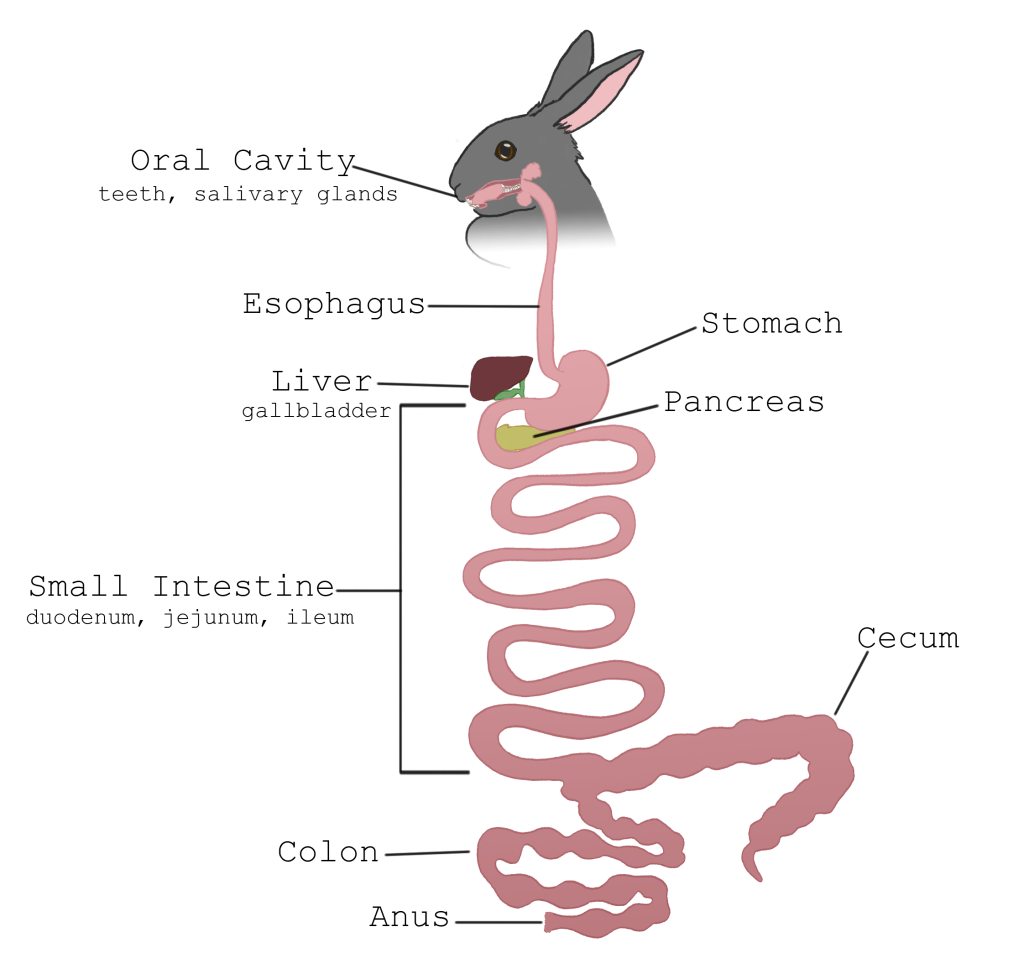 ]]>
]]>
268
50
3
0
Fri, 17 Nov 2023 19:00:58 +0000
<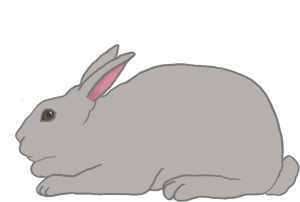 This interactive book will teach you about the rabbit digestive system (or, as well like to call it, the “bunny belly!”) Follow along as we go learn about the different parts of a bunny’s belly, how it works, and what can go wrong! ]]>
This interactive book will teach you about the rabbit digestive system (or, as well like to call it, the “bunny belly!”) Follow along as we go learn about the different parts of a bunny’s belly, how it works, and what can go wrong! ]]>
4
0
1
0
https://open.lib.umn.edu/bunnybellies/?post_type=chapter&p=5
Fri, 17 Nov 2023 19:00:58 +0000
https://open.lib.umn.edu/bunnybellies/?p=5
<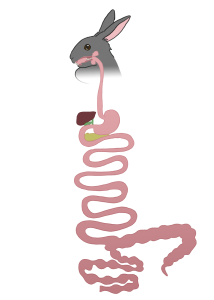
In this section you will…
- Learn the function of each digestive organ….
- Understand the importance of rabbit dental health…
- Be able to explain the importance of the cecum in the rabbit digestive system…
]]>
5
50
1
0
Fri, 17 Nov 2023 19:00:58 +0000
<![CDATA[ ]]>
7
0
0
0
Fri, 17 Nov 2023 19:00:59 +0000
<![CDATA[ ]]>
8
0
0
0
https://open.lib.umn.edu/bunnybellies/table-of-contents/
Fri, 17 Nov 2023 19:00:59 +0000
https://open.lib.umn.edu/bunnybellies/table-of-contents/
<![CDATA[ ]]>
9
0
0
0
Fri, 17 Nov 2023 19:00:59 +0000
<![CDATA[ ]]>
10
0
0
0
Fri, 17 Nov 2023 19:00:59 +0000
<![CDATA[ ]]>
11
0
0
0
Fri, 17 Nov 2023 19:00:59 +0000
<![CDATA[ ]]>
12
0
0
0
Fri, 17 Nov 2023 19:00:59 +0000
https://open.lib.umn.edu/bunnybellies/?p=16
16
0
1
0
Fri, 17 Nov 2023 19:01:09 +0000
<![CDATA[ ]]>
21
0
1
0
https://open.lib.umn.edu/bunnybellies/?post_type=front-matter&p=22
Fri, 17 Nov 2023 19:12:00 +0000
https://open.lib.umn.edu/bunnybellies/?post_type=front-matter&p=22
22
0
2
0
Fri, 17 Nov 2023 19:15:00 +0000
<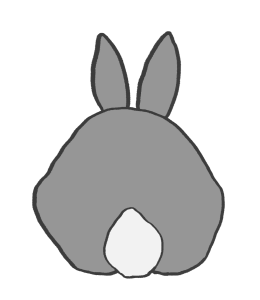
]]>
24
0
1
0
Mon, 27 Nov 2023 14:19:55 +0000
<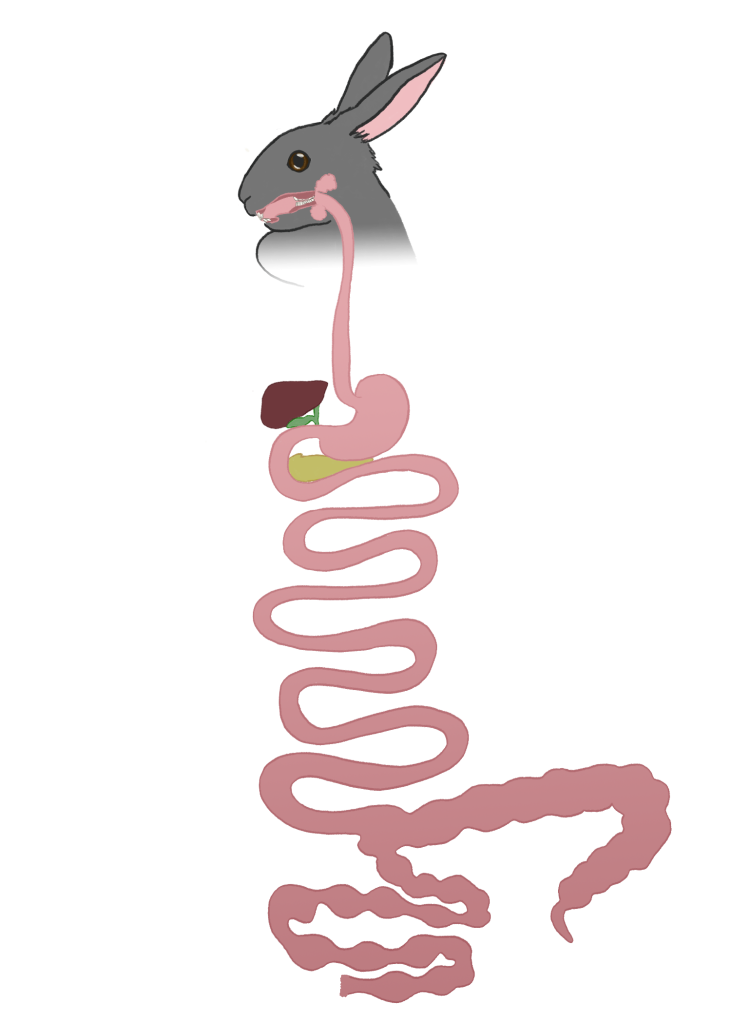 ]]>
]]>
50
0
2
0
Mon, 27 Nov 2023 14:52:24 +0000
<![CDATA[ Most common presentations for a rabbit is gastrointestinal stasis. Gastrointestinal stasis (GI stasis) is a condition where the rabbit’s digestive system slows down or completely stops moving. This can cause a rabbit to die in as little as 24 hours if not treated, but as you’ll soon learn, GI stasis can be caused by quite a number of things. ]]>
66
0
3
0
https://open.lib.umn.edu/bunnybellies/?post_type=chapter&p=103
Mon, 27 Nov 2023 16:17:07 +0000
https://open.lib.umn.edu/bunnybellies/?post_type=chapter&p=103
<
Rabbits are prey animals…
Prey animals hide signs that they are in pain or sick–this prevents predators from singling them out as an easy catch. Unfortunately for us, this means it can be hard to identify when our bunnies are not feeling well. Here are some helpful examples of bunny body language you can use to identify an ill rabbit. Remember: a rabbit experiencing pain can lead to them developing secondary RGIS!
Below are a couple of helpful resources to learning how to spot a sick and/or painful bunny!
 ]]>
]]>
103
24
2
0
https://open.lib.umn.edu/bunnybellies/?post_type=chapter&p=110
Mon, 27 Nov 2023 16:24:08 +0000
https://open.lib.umn.edu/bunnybellies/?post_type=chapter&p=110
110
108
1
0
https://open.lib.umn.edu/bunnybellies/?post_type=chapter&p=114
Mon, 27 Nov 2023 16:26:06 +0000
https://open.lib.umn.edu/bunnybellies/?post_type=chapter&p=114
<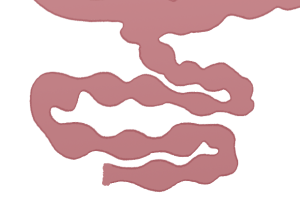 ]]>
]]>
114
50
3
0
https://open.lib.umn.edu/bunnybellies/?post_type=chapter&p=116
Mon, 27 Nov 2023 16:26:50 +0000
https://open.lib.umn.edu/bunnybellies/?post_type=chapter&p=116
116
108
2
0
https://open.lib.umn.edu/bunnybellies/?post_type=chapter&p=230
Tue, 28 Nov 2023 19:46:22 +0000
https://open.lib.umn.edu/bunnybellies/?post_type=chapter&p=230
230
24
1
0
https://open.lib.umn.edu/bunnybellies/?post_type=chapter&p=264
Wed, 29 Nov 2023 19:03:49 +0000
https://open.lib.umn.edu/bunnybellies/?post_type=chapter&p=264
< ]]>
]]>
264
50
1
0
https://open.lib.umn.edu/bunnybellies/?post_type=part&p=3
Fri, 17 Nov 2023 19:00:58 +0000
https://open.lib.umn.edu/bunnybellies/?p=3
3
0
1
0
https://open.lib.umn.edu/bunnybellies/?post_type=part&p=26
Fri, 17 Nov 2023 19:15:33 +0000
https://open.lib.umn.edu/bunnybellies/?post_type=part&p=26
26
0
2
0
https://open.lib.umn.edu/bunnybellies/?post_type=part&p=60
Mon, 27 Nov 2023 14:28:50 +0000
https://open.lib.umn.edu/bunnybellies/?post_type=part&p=60
< The function of teeth is to physically break down food into smaller pieces. Rabbits have aradicular hypsodont teeth. Unlike human, dogs and cats, rabbits have teeth that continue to grow throughout their lifetime. They have an “open root,” so they do not have a defined root, which allows them to constantly replace the part of the tooth that gets worn down as they eat the rough fiber of their diet (i.e. hay.) Other animals with teeth in this category include guinea pigs and chinchillas.
The function of teeth is to physically break down food into smaller pieces. Rabbits have aradicular hypsodont teeth. Unlike human, dogs and cats, rabbits have teeth that continue to grow throughout their lifetime. They have an “open root,” so they do not have a defined root, which allows them to constantly replace the part of the tooth that gets worn down as they eat the rough fiber of their diet (i.e. hay.) Other animals with teeth in this category include guinea pigs and chinchillas.

When a rabbit chews hay, they chop it up with their sharp incisors (their front teeth) and then grind it down with their “cheek teeth,” a group of molars near the back of the mouth that grind down the plant material to be swallowed. Chewing food increases the surface area thereby increasing the rate of reaction with digestive enzymes. Salivary glands filled with saliva and enzymes to start breaking down starch to convert it into sugar. The saliva also provides lubrication for the food to go down the esophagus, the tube of muscle that connects the mouth to the stomach.
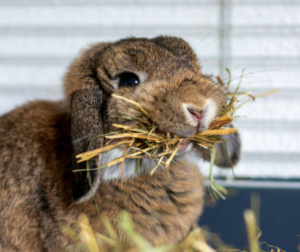
A lot can go wrong when your teeth can’t stop growing. These bunny rabbits need constantly eat hay to wear down their teeth, but what happens if they don’t have enough access to hay, or if their teeth are misaligned? We’ll learn more about this in chapter 3. ]]>
60
0
2
0
https://open.lib.umn.edu/bunnybellies/?post_type=part&p=69
Mon, 27 Nov 2023 14:55:00 +0000
https://open.lib.umn.edu/bunnybellies/?post_type=part&p=69
69
0
2
0
https://open.lib.umn.edu/bunnybellies/?post_type=part&p=71
Mon, 27 Nov 2023 14:57:13 +0000
https://open.lib.umn.edu/bunnybellies/?post_type=part&p=71
<![CDATA[
In this section you will…
- Learn the behaviors and body language of a rabbit in pain.
- Explain why a rabbit may hide their symptoms.
- Understand the importance of taking immediate action when you notice a rabbit is in pain.
]]>
71
0
4
0
Mon, 27 Nov 2023 15:52:52 +0000
<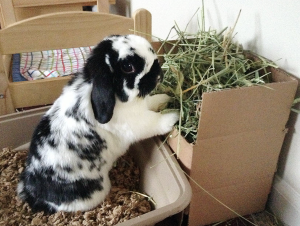
]]>
94
0
2
0
Mon, 27 Nov 2023 16:23:30 +0000
<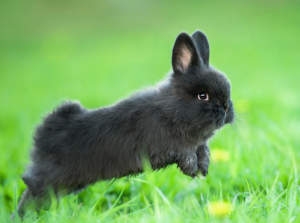 In this section you will…
In this section you will…
- Learn what a proper rabbit habitat should look like.
- Know how much exercise a rabbit needs each day.
- Understand the importance of enrichment in a bunny’s life and how all of this circles back to maintaining a healthy bunny belly.
]]>
108
0
4
0
https://open.lib.umn.edu/bunnybellies/?post_type=part&p=237
Wed, 29 Nov 2023 03:58:37 +0000
https://open.lib.umn.edu/bunnybellies/?post_type=part&p=237
237
0
5
0
https://open.lib.umn.edu/bunnybellies/part/249-2/
Wed, 29 Nov 2023 04:26:57 +0000
https://open.lib.umn.edu/bunnybellies/?post_type=part&p=249
249
0
5
0

